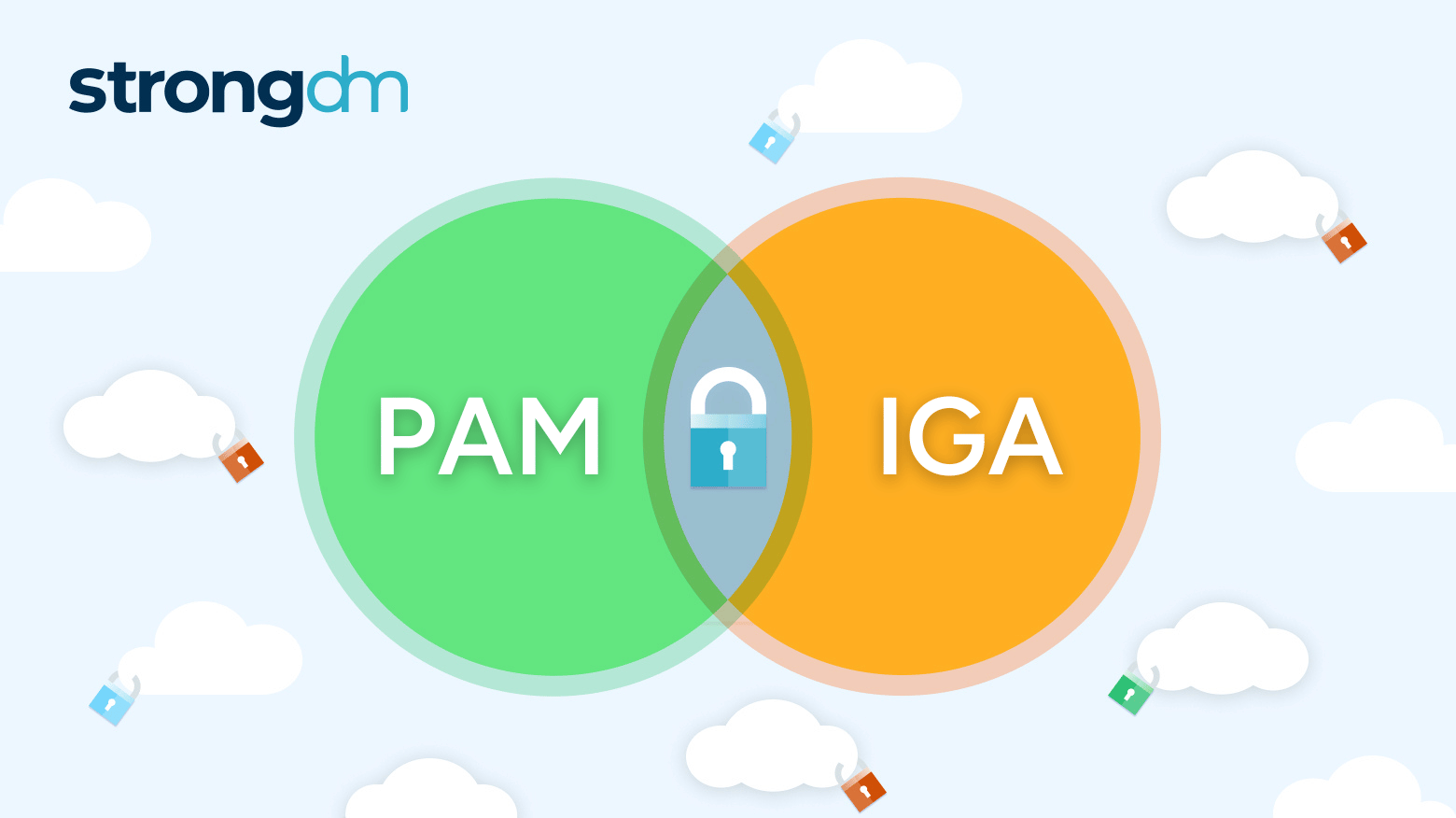IGA vs. PAM: What’s the Difference?


Written by
Fazila MalikLast updated on:
October 17, 2025Reading time:
Contents
Built for Security. Loved by Devs.
- Free Trial — No Credit Card Needed
- Full Access to All Features
- Trusted by the Fortune 100, early startups, and everyone in between
It’s important for IT teams to recognize the unique yet complementary roles of Identity Governance and Administration (IGA) and Privileged Access Management (PAM) in an organization's identity and access management strategy. There are certainly reasons for using both tools to enhance enterprise security, particularly for privileged accounts, and covers their respective functionalities, including user lifecycle management, access compliance, and privileged account monitoring. Additionally, it includes a feature comparison chart and a summary to provide a clear understanding of the differences and benefits of IGA and PAM.
IGA vs. PAM: What’s the Difference?
IGA (Identity Governance and Administration) manages user identities and access across the organization, ensuring proper access and compliance. PAM (Privileged Access Management) secures privileged accounts with elevated permissions by using measures like credential vaulting and session monitoring to prevent misuse. While IGA handles overall user access, PAM adds security for the most sensitive accounts.
IGA focuses on the overall lifecycle of user identities, ensuring that the right people have the right access to the right resources at the right time and maintaining compliance through broad user access governance.
PAM, on the other hand, zeroes in on privileged accounts—those with elevated permissions—providing enhanced security measures like credential vaulting, session monitoring, and just-in-time access to prevent misuse and mitigate insider threats.
While IGA ensures proper access for all users, PAM adds a critical layer of security for the most sensitive accounts.
IGA and PAM Definitions
Identity Governance and Administration (IGA): IGA tools focus on managing and governing the lifecycle of user identities within an organization. This includes user provisioning, access request management, role management, certification and attestation, policy enforcement, and audit reporting. The primary goal of IGA is to ensure that the right individuals have the appropriate access to resources in compliance with organizational policies and regulatory requirements.
Privileged Access Management (PAM): PAM solutions are specialized tools designed to control and monitor the access of privileged accounts within an organization. These accounts have elevated permissions that can make significant changes to systems, applications, and data. PAM focuses on securing, managing, and auditing these high-level accounts to prevent misuse and reduce the risk of insider threats.
Why Use a PAM Tool in Addition to an IGA Tool?
While Identity Governance and Administration (IGA) and Privileged Access Management (PAM) tools both play crucial roles in an organization's identity and access management strategy, they serve different purposes and offer complementary functionalities. Here's why an organization might need both:
Enhanced Security for Privileged Accounts
IGA tools manage the access lifecycle for all users, ensuring appropriate access and compliance across the organization. However, privileged accounts require additional layers of security due to their elevated permissions and potential impact if compromised. While IGA ensures appropriate access rights and compliance across the organization, PAM offers more granular control and monitoring for privileged accounts. PAM tools provide enhanced security by:
- Securing Privileged Credentials: PAM tools store and manage privileged credentials in secure vaults, reducing the risk of theft or misuse.
- Enforcing Strong Authentication: PAM tools often implement multifactor authentication (MFA) specifically for privileged accounts, adding an extra layer of security.
- Session Monitoring and Recording: PAM tools can monitor and record sessions involving privileged access, providing visibility and audit trails to detect and respond to suspicious activities.
- Just-in-Time Access: PAM tools can grant temporary privileged access for specific tasks, reducing the time windows during which privileged credentials can be misused.
- Continuous Monitoring: PAM tools continuously monitor privileged account activities in real-time, enabling immediate detection and response to potential threats.
Identifying & Reducing Insider Threats
Privileged accounts are a prime target for insider threats due to their extensive access rights. PAM tools help mitigate these threats by:
- Limiting Access to Sensitive Systems: PAM tools ensure that only authorized individuals can access critical systems and data, reducing the risk of internal misuse.
- Implementing Segregation of Duties: PAM tools enforce policies that prevent a single user from having unchecked control over sensitive systems, thereby reducing the risk of fraud or sabotage.
- Automating Responses to Anomalies: PAM tools can automatically trigger alerts and responses to unusual activities involving privileged accounts, helping to prevent potential breaches.
Compliance and Risk Management
While IGA tools provide broad compliance support across all user accounts, PAM tools offer specific controls and reporting capabilities for privileged accounts that are often required by regulations and industry standards. Benefits include:
- Regulatory Compliance: PAM tools help organizations meet stringent compliance requirements related to the management of privileged accounts, such as those found in PCI DSS, HIPAA, and SOX.
- Risk Reduction: By securing privileged accounts and monitoring their usage, PAM tools reduce the overall risk of data breaches and other security incidents.
- Audit Readiness: PAM tools provide comprehensive reports and audit trails for privileged account activities, facilitating easier and more accurate compliance audits.
IGA and PAM Key Differences
1. Scope of Management:- IGA: Manages all user identities and their access rights across the organization.
- PAM: Specifically manages privileged accounts with elevated permissions.
- IGA includes identity lifecycle management, role management, and access certification for all users.
- PAM includes credential vaulting, session management, and just-in-time access specifically for privileged users.
- IGA: Strong emphasis on regulatory compliance and comprehensive audit trails for all user access.
- PAM: Emphasizes audit and monitoring of privileged account activities to detect and prevent misuse.
- IGA: Mitigates risks associated with inappropriate access by regular certification and review of access rights.
- PAM: Reduces risks of insider threats by controlling and monitoring privileged account usage.
Feature Comparison Chart
| Feature/Function | IGA | PAM |
|---|---|---|
| User Provisioning | Yes, for all users | Primarily for privileged users |
| Access Request | Yes, for all users | Typically for elevated access |
| Role Management | Extensive role-based access control | Focuses on privileged roles |
| Certification | Regular access reviews for compliance | Specific to privileged account reviews |
| Policy Enforcement | Broad policy enforcement for all access | Strict policies for privileged access |
| Audit and Reporting | Comprehensive audit trails | Detailed logging of privileged actions |
| Authentication | Standard and multifactor authentication | Multifactor authentication for privileged accounts |
| Session Monitoring | Basic user session tracking | Detailed session recording and monitoring |
| Password Management | General password policies | Secure storage and rotation of privileged passwords |
| Threat Detection | General access anomaly detection | Real-time monitoring for privileged account abuse |
IGA and PAM in the Modern Tech Stack
While IGA tools provide essential identity management and governance capabilities for all users within an organization, PAM tools offer specialized security, monitoring, and control for privileged accounts. Together, they form a comprehensive identity and access management strategy that enhances security, reduces risks, and ensures compliance with regulatory requirements.
Want to learn more? Sign up for our demo and see for yourself.
Next Steps
StrongDM unifies access management across databases, servers, clusters, and more—for IT, security, and DevOps teams.
- Learn how StrongDM works
- Book a personalized demo
- Start your free StrongDM trial

Categories:

About the Author
Fazila Malik, Sales Enablement Expert, as an accomplished Product Marketing Manager in the technology industry with over 5 years of experience, Fazila transitioned to a Sales Enablement leader position passionate about empowering go-to-market teams to excel in their roles. Throughout her career, she has worked with a range of technology products, including software applications and cloud-based solutions. Fazila is a member of the Product Marketing Alliance and an AWS Cloud Certified Practitioner. To contact Fazila, visit her on LinkedIn.
You May Also Like




